We now live in a time when data has been declared the new fuel. Today’s world is flooded with ever-increasing amounts of Big Data. Businesses and people together create massive amounts of data every minute. Every company that uses digital signage relies on Big Data and the useful insights it provides. Processing such large volumes of data requires the need for fast and efficient Modern Data Analytics Tools like Oracle Analytics Cloud (OAC).
`Today’s Big Data Analytics Solutions combine multiple and unique Data Sources efficiently. They can analyze massive data volumes and at the same time reduce Compliance Analytics Cycle Times from weeks to days. To stay one step ahead of their competition, most of these enterprise solutions emphasize automation of Data Gathering and Distribution Systems, and OAC addresses these needs in various ways.
In this guide, we cover all the basic concepts to get you started with OAC: ranging from features, components, and importing and exporting a workbook to adding data and creating visualizations.
Table of Contents
Prerequisites
To benefit the most from this guide, we recommend that you have:
- Understanding of Data Analytics.
- Access to Oracle Analytics Cloud or Oracle Analytics Desktop.
Providing a high-quality ETL solution can be a difficult task if you have a large volume of data. Hevo’s automated, No-code platform empowers you with everything you need to have for a smooth Oracle data replication experience.
Check out what makes Hevo amazing:
- Live Monitoring & Support: Hevo provides live data flow monitoring and 24/5 customer support via chat, email, and calls.
- Secure & Reliable: Hevo’s fault-tolerant architecture ensures secure, consistent data handling with zero loss and automatic schema management.
- User-Friendly & Scalable: Hevo’s simple UI makes it easy for new users, while its horizontal scaling manages growing data volumes with minimal latency.
- Efficient Data Transfer: Hevo supports real-time, incremental data loads, optimizing bandwidth usage for both ends.
What is Oracle Analytics Cloud?

Oracle Analytics Cloud or OAC is an AI-powered Self-Service Analytics Platform that provides enterprises with superior reporting and analytics capabilities. It compiles and analyzes data for patterns before turning it into a user-friendly representation. This allows users to understand business operations better and create more accurate predictions and projections.
OAC goes beyond the standard drag-and-drop Data Analysis Solutions as it generates AI-based insights. It automatically offers suggestions to quickly analyze data by anticipating your data requirements. You can also evaluate future outcomes using OAC in just a few clicks. OAC is a must-have for enterprises seeking to supplement insight delivery with better Machine Learning approaches.
OAC collects information from reputable public sources to produce new columns, such as population counts for various states, allowing you to analyze your current data better. Oracle can produce reports in English from your visualizations with only one click, making visualization delivery even easier. These tools enable you to create insights rapidly and communicate reports swiftly to help you make timely decisions. When paired with digital signage, OAC’s visual insights can be displayed in real time across business spaces. In simple words, you can link data from different sources, transform it, and build a single source of truth for Self-Service Data Visualization in OAC, all from the convenience of a web browser on your preferred device.
Related:
- OAC Data Replication: 4 Easy Steps to Start Your Data Flow
- Tableau Oracle Connection Made Easy
- Setting up Oracle CDC (Change Data Capture): 2 Easy Methods
Features of Oracle Analytics Cloud (OAC)
- Comprehensive Insights: Oracle Analytics Cloud makes it simple for your company to streamline Data Preparation and Management. It can leverage data from any source and provide in-context analysis to help you make the best business decisions.
- Machine Learning: One of the best features of OAC is that it doesn’t limit self-service to Data Preparation and Visualization. It also has Machine Learning tools, allowing users to create no-code models.
Create your Data Pipeline in as easy as three clicks. Hevo Data’s No-Code tools simplify Data Ingestion & Transformation from your Oracle Database to your Data Warehouse. Try for free today!
- Automatic Updates: Oracle Analytics Cloud has lifecycle management features that are automated. This means that businesses don’t have to worry about hosting or software upgrades.
- Conversational Analytics: You may ask analytical questions in Natural Language Queries as if you were speaking to a friend. To explain visualizations and trends, OAC provides automatically generated natural language explanations of results. It also provides support and assistance from chatbots across datasets to increase data literacy, allowing non-technical individuals to connect directly with data.
- What-If Scenarios: OAC uses a native Multidimensional Analysis Engine called Oracle Essbase to construct advanced business models to help you generate accurate predictions and forecasts.
- Embeddability: Oracle Analytics Cloud also allows App Developers to design and integrate OAC reports and analytics into their applications. This feature saves your app users time by eliminating the need to register a separate account or check in to OAC to view their reports. Instead of going to OAC to visualize data, customers may make decisions from the application they are most familiar with.
- Cost-effectiveness: OAC helps you to share results and generate meaningful insights at a cheaper cost by allowing quick analysis without extensive coding or technical know-how. It’s easy to scale to fit changing company demands, much like other cloud-based solutions, without the need to construct and manage external hardware resources.
Components of Oracle Analytics Cloud
- Oracle Data Visualization Cloud Service (DVCS) and Oracle Business Intelligence Cloud Service (BICS)
- Oracle Smart View
- Oracle Day by Day
- Oracle Essbase
Oracle Data Visualization Cloud Service (DVCS) and Oracle Business Intelligence Cloud Service (BICS)
DVCS and BICS are proven Business Analytics and Data Visualization Systems that are available as Software-as-a-Service (Saas). Offering these services under the Oracle Analytics Cloud umbrella allows your Line of Business users to sign up for these services in a public cloud environment hosted and administered by Oracle. It also allows them to maintain control over the domain while migrating to the cloud. Instead of duplicating the Data Models, the Business Intelligence Cloud will enable you to reuse this component to develop visualizations in OAC.
Oracle Smart View
It is a powerful tool that enables you to explore and integrate Oracle Analytics Cloud BI Content with Microsoft Office applications. Using Smart View, users may examine, import, alter and share data in Microsoft Office Excel, Word, and PowerPoint.
Oracle Day by Day
This is the first Enterprise Analytics Tool that utilizes Artificial Intelligence (AI) to evaluate what you examine in OAC and automatically display reports and insights. Based on your searches for business data in the app, it learns what you’re interested in, when and where you’re interested in it and generates the Data Insights in ready-to-use analytical chart cards.
These analytical cards are accessible whenever, and anywhere you want without having to look for them again. You can share and work on the analytical cards discreetly with individual users or groups of users. The app also allows you to generate analytical cards using voice queries.
Oracle Essbase
The classic Essbase tool is the leading technology for Multidimensional Online Analytical Processing. It is designed primarily for Business Users and Data Analytics (BI) Professionals as it covers a variety of functions, including what-if analysis, budget analysis, forecasting, root cause analysis, and scenario planning. Essbase is now available as a subscription-based cloud service called EssCs from OAC (Essbase Cloud Service). It allows for Data Backup and Migration, as well as the distribution of application templates across your business without sacrificing usability or self-service choices.
It incorporates the finest of on-premises software and adds cloud-specific capabilities. You can expand the size and complexity of your models while lowering the time and effort required to deploy them. The cloud platform service provides you with custom technology, which allows you to quickly deploy on-the-fly analytic models that can be enhanced as your business needs change or are scrapped in favor of new models.
Oracle Analytics Cloud Pricing
Oracle Analytics Cloud offers a variety of pricing options to provide consumers with more flexible subscriptions. Even though a 30-day free trial is available, premium subscriptions for enterprise and professional versions are divided into two categories: OCPU per hour and user per month. While OCPU costs $0.3226 to $2.1506 per hour, the user per month plan costs from around $16 to $80.
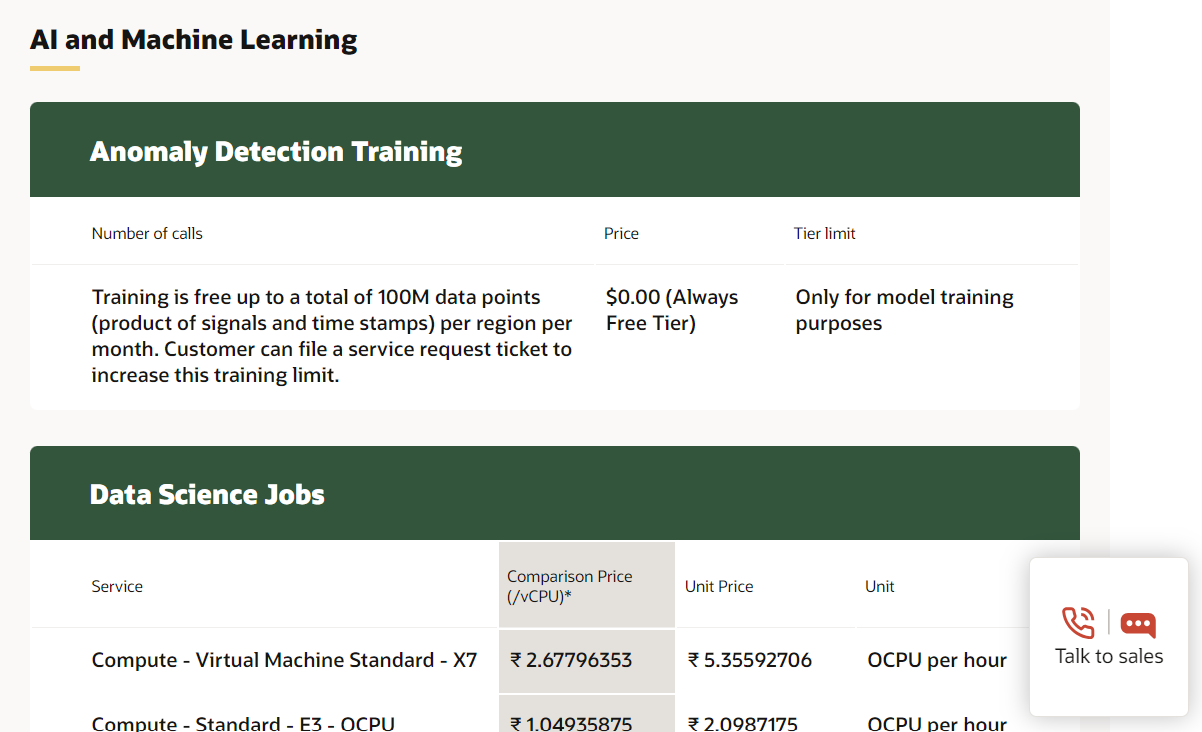
How to Add Data in OAC?
In this section, we discuss how to add data to your OAC. The example uses the sample revenue.xlsx file.
Step 1: Use your Oracle Analytics credentials to log in.
Step 2: Click Create, then Workbook, from the Home page.
Step 3: Click Create Dataset under Add Dataset.
Step 4: Click “Drop data file here” or click “Browse” in Create Dataset, then choose the sample revenue.xlsx file and click Add.
Step 5: Click Add under the Add Dataset section. Click Create Workbook on the Transform page.
Step 6: Hold down the Ctrl key and drag the following to the canvas from the Data panel:
- PROD_TYPE
- REVENUE
- DEPARTMENT
Oracle Analytics selects the most appropriate visualization type for the data items.
Step 7: Select Horizontal Stacked as the visualization type from the list of visualization types.
Step 8: Drag DEPARTMENT to Color so that PROD_TYPE and DEPARTMENT swap positions in the Grammar panel.
How to Filter Data in OAC?
Filtering data in OAC is as easy as adding data. To filter your data, follow these steps:
Step 1: Click Add Filter, in the canvas.
Step 2: Select PROD_TYPE from the SAMPLE_REVENUE list.
Step 3: Select “Cell Phones” and “Smart Phones” from the PROD_TYPE list, then click within the window to exit the list.
Step 4: Select COMPANY from the Data panel and drag it to Color to replace DEPARTMENT.
Step 5: Select Clear filter options from the filter menu icon on the canvas.
Step 6: Click the Filter Menu icon next to PROD_TYPE in the filter bar, then pick Delete.
Importing and Exporting a Workbook in OAC
Import a Workbook
To import a workbook into your OAC, perform the following steps:
Step 1: Log in to Oracle Analytics.
Step 2: Select Import Workbook/Flow from the Page Menu on the Home page.
Step 3: Select File under Import Workbook/Flow.
Step 4: Locate and pick the file you want to import in File Upload. Then select Import.
Step 5: When you witness an ‘Import successful’ message, click OK.
Step 6: You can examine or edit the contents of the workbook by opening it.
Export a Workbook
To export a workbook into your OAC, perform the following steps:
Step 1: Click Workbooks and Reports from the Home page. Enter your workbook name into the search field and hit Enter.
Step 2: Pick the worksheet, then select Export from the Actions Menu.
Step 3: Select Include Connection Credentials and Include Permissions from the Export menu.
Step 4: Enter the Optional Password and Confirm Password in Protect Password, then click Save.
Step 5: Click Save File, then OK after opening the workbook.
Step 6: Select a location for the file, and then click Save.
How to Analyze Data Using a Dataset?
You can analyze data and prepare Data Visualizations for better insights. This helps you and your workgroup become aware of the entirety of your business operations and eventually make sound decisions.
To demonstrate how you can analyze data in OAC, we have used a dataset called “donation”.
Step 1: Log in to Oracle Analytics.
Step 2: Select Workbook from the Create menu on the Home page.
Step 3: Click Donation on the Add Dataset window, then Add to Workbook.
Step 4: Expand DATE_COMPLETED in the Data panel, hold down the Ctrl key, and drag Year and TOTAL_DONATIONS to the canvas.
Step 5: Hold down the Ctrl key while selecting SCH_CITY, TOTAL_DONATIONS, and NUM_DONORS in the Data panel. Right-click and select Create Best Visualization.

Step 6: To replace SCH_CITY, pick SCHOOL_ID in the Data panel and drag it to Category (Points).
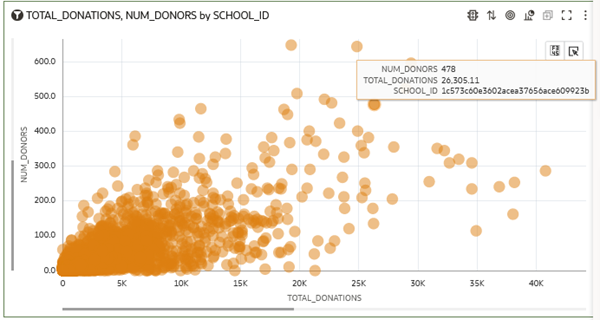
Step 7: Save the file. Enter Donation Analyses in the Save Workbook box, then click Save.
Create Visualizations with the Curated Dataset
In this example, we will use the curated dataset of the Donations by School dataset.
Step 1: Click the Data search tag on the Home page, type Donations by School, and then click Search.
Step 2: Select Create Workbook from the Action Menu symbol under Donations by School.
Step 3: Select POVERTY_LEVEL, GRADE_LEVEL, and Donation by Population in the Data panel while holding down the Ctrl key, then right-click and select Create Best Visualization.
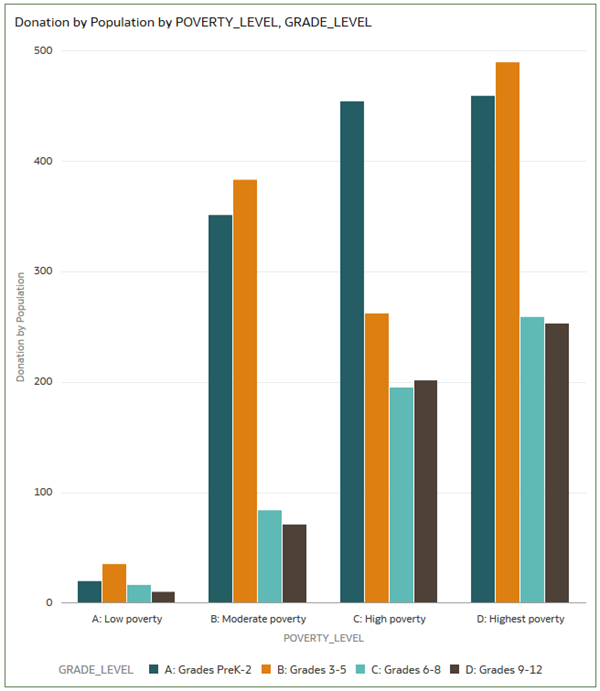
Step 4: Select Average School Donation by Income from the Data panel and drag it to Values (Y-axis) to replace Donation by Population.
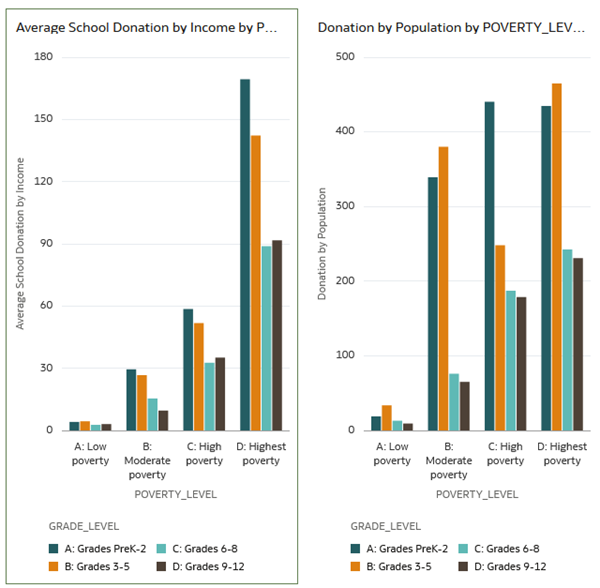
Step 5: To replace Average School Donation by Income, select TOTAL_DONATIONS in the Data panel and drag it to Values (Y-axis).
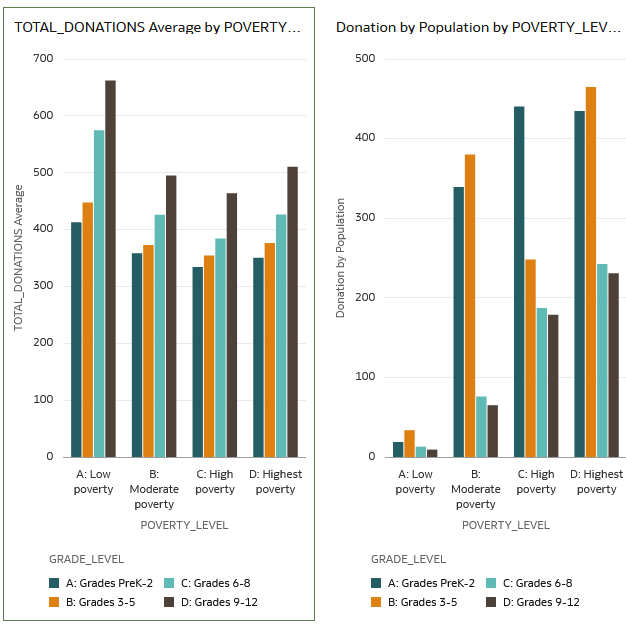
Conclusion
In this blog, we learned the basics about Oracle Analytics Cloud, its features, and some of the tasks that you can carry out using this Enterprise Data Analytics Platform. While businesses have an abundance of Data Analytics Platforms available in the market to explore, Oracle Analytics Cloud stays ahead of its competition due to automation, Machine Learning-backed features as well as flexible pricing for its users.
Hevo gives you a simple yet powerful platform to set up your own Oracle Database ETL, without worrying about the maintenance or required infrastructure. Hevo Data is the fastest ETL on the cloud to help you migrate, transform and aggregate Oracle Database data into a Data Warehouse of your choice.
Hevo also allows the integration of data from non-native sources using Hevo’s in-built REST API & Webhooks Connector. You can then focus on your key business needs and perform insightful analysis using BI tools. Try a 14-day free trial and experience the feature-rich Hevo suite firsthand. Also, check out our unbeatable pricing to choose the best plan for your organization.
FAQs
1. How does OAC ensure data security?
OAC follows Oracle’s robust security protocols, including encryption, user access controls, and compliance with global standards.
2. Who can benefit from using OAC?
Businesses of any size can utilize OAC for data-driven decision making, especially those already working with Oracle’s ecosystem.
3. Can OAC handle real-time data?
Yes, OAC processes and visualizes real-time data for insights in real-time or for ongoing monitoring.



